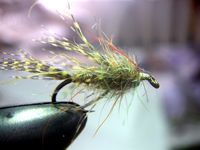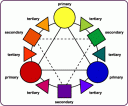 I mentioned the “Bird’s Nest” fly in last nights post, I had the privilege of knowing Calvert Bird years ago when it was created. Cal was one of the most singular and gentle fellows I’ve ever known, he had a weakness for coffee and wreath cake, which I exploited unmercifully.
I mentioned the “Bird’s Nest” fly in last nights post, I had the privilege of knowing Calvert Bird years ago when it was created. Cal was one of the most singular and gentle fellows I’ve ever known, he had a weakness for coffee and wreath cake, which I exploited unmercifully.
All of Cal’s well known flies are generalist patterns, you won’t find individual legs, or precise structure that limits the fly to a single genus and species; Cal was a trained artist, a calligrapher by trade, and his artistic skills imbued all of his work.
Cal had retired and lived across the street from Frank Matarelli, the “father” of all of the fly tying tools we use today. Watching that pair in action was always a treat, as gentle and soft spoken as Cal was, Frank was strident and bellicose. They often collaborated, Cal would fiddle with Frank’s tools, and Frank would berate Cal for using them wrong, or some other imagined offense.
The Bird’s Nest pattern was invented around 1984. Cal tested the fly on trips to Hat Creek, and handed them with a knowing wink to his friends, “Try these,” was all he would say.
The original pattern was a precise blend of fur not seen in today’s commercial versions. 50% gray Australian Opossum, 40% Hare’s Mask (with guard hairs intact) and 10% Natural baby Seal fur. Cal preferred the heavily barred Teal flank feathers for the hackle, these were dyed with RIT Maple Sugar cloth dye.
The rear of the fly was left naturally unruly, the combination of the guard hairs, coarse seal fur, and Australian Opossum was untamable. The head of the fly was combed with the male side of Velcro, to increase the visible spike of the hair, and merge it with the teal flank.
The hackle was also applied differently, Cal would cut the center out of a flank feather and strip back the balance, leaving a small “chevron” of flank feather on each side. The amount depended on the size of the finished fly, perhaps a 1/4″ for small flies, 1/2″ for larger #8’s and above. He would press one side onto the fly with his thumb, and would use the thread to distribute the fibers. As the thread circled the far side of the fly, he would press the remaining teal close to the shank with his forefinger, then allow the thread to distribute the fibers along the far side and belly of the fly.
The fly originally debuted in two flavors, Natural (the fly we use today) and Spectral.
 The Spectral Bird’s Nest was pure artist. Formal art training introduces the Artist’s Color Wheel, all colors are mixed from only three; Red, Yellow, and Blue. Secondary colors are mid-way between primaries, mix yellow and blue to get green, red and yellow to get orange, red and blue yields purple.
The Spectral Bird’s Nest was pure artist. Formal art training introduces the Artist’s Color Wheel, all colors are mixed from only three; Red, Yellow, and Blue. Secondary colors are mid-way between primaries, mix yellow and blue to get green, red and yellow to get orange, red and blue yields purple.
To get the Spectral Bird’s Nest, Cal used the Australian Opossum / Hare’s Ear base, and replaced the 10% natural seal, with 10% comprised of red, yellow, blue, orange, green, and purple, seal. All of the primary and secondary colors on the color wheel.
He would press a couple into your hand, with, “Fish see whatever they want with these.”
It is one of the best all-round searching flies I’ve used, and I can find no reference to it anywhere. Today’s tiers can substitute any coarse synthetic for the seal, it must be unruly enough to stick out from the Opossum/Hare’s Mask blend – as seal does. The completed fly should have “guard hairs” of colored fiber sticking out of the grey base, not buried in the gray where it will not be seen.
Spectral Bird’s Nest HiRez image
I have a date with an effluent creek, see you on the “Brownline” …
Tags: Calvert Bird, fly tying, Bird’s Nest, Spectral Bird’s Nest, color wheel

Cool stuff, though I had no idea you were that old…
I’m gonna nail you with a snappy comeback line right after I hose my tackle down, Brownline? I would have labelled it, Freestone Mocha, at least that way I wouldn’t feel self conscious..
Brownlining is brilliant. And you can’t fight brilliant no matter how many coffee metaphors you spring.
Cal Bird was one of our sports fine gentlemen. He always had a thoughtful answer to any question, and would share any technique. I remeber him tying a mini-muddler from teal flank feathers and dubbing blend, just to demonstrate different uses of the materials. The Spectral Bird’s Nest is genius and has long been one of my favorite searching nymphs.
Cal Bird was a genius. Chuck Strannahan told me they IQ tested Cal at Stanford and he scored off the charts.
..tested Cal at Stanford?
Had many fishing trips with my brother.His life was all on fishing.
William,
I don’t think I’ve met a finer, gentler human. If you’re his brother, you were mighty fortunate.
Fishing, yes that was his life most of the time.I remember back many years ago,he was a smart young man,well dressed -loved to dance-he loved snow, many trips we made together for looking for snow to ski in–A great brother to travel with. You see, in the days way back when, we had no money to spend for much.Our dad filled the model-A for our snow trips.—I might also tell you that he was a fighter also. When he was in the CCC, he was in the ring often.
“Bud”
Cal Bird is my father. If any ones has any information or antedotes regardind Dad I would appreciate them being shared.
Thank You,
Cal Bird
All the Birds are coming home to roost right here.
I didn’t know Calvert lived across the street from Frank Matarelli? Guess they didn’t get much yard work done. All seriousness aside, love their contributions to the art of fly tying.
Used to tie and fish a lot, but sat out for a few years there with family priorities (and being de-focused for some years with a sideline hang gliding fascination) and such. Amazingly in all those years I’d never heard of the Bird’s Nest until very recently. And I’ve been based in CA for 20 years now, too, which makes it all the more curious I’d never come across it. With tying vise still in a box somewhere, I’d love to find a source of reasonably authentic natural and spectral Bird’s Nests that I could get hold of and try. Not the black things and depth charges and all those others that claim to be Bird’s Nest variants, but something like what Cal himself developed.
The fact that the pattern is said to have a “universal” kind of quality appeals to me at a stage in life in which I still lack the time to study entomology of every little stream or arrange to be right there when little hatches occur and such.
Anyone know a source of this fly? I see versions for sale that to me look nothing like Cal’s or that look like they’re tied with hunks of hemp. Just looking for a few good ones, in natural and spectral both. Suggestions?
Sure wish I’d met Cal.